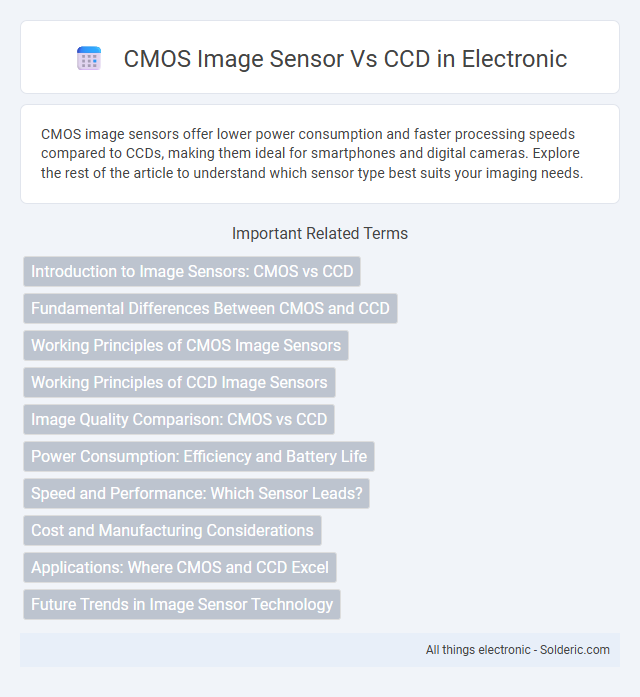CMOS image sensors offer lower power consumption and faster processing speeds compared to CCDs, making them ideal for smartphones and digital cameras. Explore the rest of the article to understand which sensor type best suits your imaging needs.
Comparison Table
| Feature | CMOS Image Sensor | CCD (Charge-Coupled Device) |
|---|---|---|
| Technology | Complementary Metal-Oxide-Semiconductor | Charge-Coupled Device |
| Power Consumption | Low power consumption | High power consumption |
| Image Quality | Good, improved with advanced designs | High image quality with low noise |
| Speed | High-speed readout and processing | Slower readout speed |
| Cost | Lower manufacturing cost | Higher manufacturing cost |
| Sensitivity | Lower sensitivity to light | Higher sensitivity, better for low-light |
| Integration | Easy integration with on-chip circuits | Requires external circuitry |
| Pixel Size | Smaller pixels possible | Typically larger pixels |
| Use Cases | Smartphones, webcams, automotive cameras | Professional cameras, astronomy, scientific imaging |
Introduction to Image Sensors: CMOS vs CCD
CMOS (Complementary Metal-Oxide-Semiconductor) image sensors utilize integrated circuits to capture images with lower power consumption and faster processing speeds compared to CCD (Charge-Coupled Device) sensors. CCD image sensors excel in producing higher image quality with better light sensitivity and less noise, making them suitable for professional photography and scientific applications. Your choice depends on factors like application requirements, power efficiency, and image quality preferences.
Fundamental Differences Between CMOS and CCD
CMOS Image Sensors utilize active pixel sensors where each pixel contains a photodetector and amplifier, enabling faster readouts and lower power consumption. CCD sensors transfer charge across the chip to a single readout point, offering high image quality with lower noise but consuming more power. The fundamental difference lies in CMOS's integration of signal processing within each pixel versus CCD's centralized charge transfer mechanism.
Working Principles of CMOS Image Sensors
CMOS image sensors operate by converting light into electrical signals using photodiodes integrated with active pixel sensors, allowing individual pixel amplification and faster data readout. Unlike CCDs, which transfer charge across the chip to a single output node, CMOS sensors process signals directly within each pixel, enabling lower power consumption and higher frame rates. Your choice of sensor can impact image quality, speed, and power efficiency depending on the application's specific requirements.
Working Principles of CCD Image Sensors
CCD (Charge-Coupled Device) image sensors operate by converting light into electronic charge within an array of photodiodes, which is then transferred across the chip to an output node for digital conversion. The charge transfer occurs through a series of capacitors, enabling high-quality image capture with low noise and excellent light sensitivity. Understanding the working principle of CCD sensors helps you appreciate their advantages in applications requiring precise and detailed image sensing.
Image Quality Comparison: CMOS vs CCD
CMOS image sensors offer faster readout speeds and lower power consumption, making them ideal for dynamic imaging applications, whereas CCD sensors typically deliver higher image quality with better light sensitivity and lower noise levels, especially in low-light conditions. CCDs use a charge transfer process that results in uniform pixel response and higher dynamic range, which can produce cleaner and more detailed images compared to CMOS sensors that integrate pixel amplification individually. Your choice between CMOS and CCD will depend on the specific requirements for image clarity, sensitivity, and power efficiency in your application.
Power Consumption: Efficiency and Battery Life
CMOS image sensors consume significantly less power than CCD sensors, enhancing power efficiency and extending battery life in portable devices. Your devices benefit from the low-voltage operation of CMOS technology, making it ideal for cameras in smartphones and wearables. This reduced power consumption allows longer usage times without frequent recharging, optimizing overall energy management.
Speed and Performance: Which Sensor Leads?
CMOS image sensors generally offer faster readout speeds than CCD sensors due to their parallel processing architecture, enabling rapid image capture ideal for high-speed applications like video and burst photography. CCD sensors, while slower, excel in image quality with lower noise levels and higher sensitivity, making them superior for long exposures and scientific imaging. Performance-wise, CMOS sensors dominate in speed and power efficiency, whereas CCD sensors maintain an edge in noise performance and uniformity.
Cost and Manufacturing Considerations
CMOS image sensors generally offer lower manufacturing costs due to compatibility with standard semiconductor fabrication processes, enabling higher yield rates and integration with on-chip circuitry. CCD sensors require specialized manufacturing steps that increase production expenses and limit scalability. Cost efficiency of CMOS technology makes it the preferred choice for mass-market applications like smartphones and automotive imaging.
Applications: Where CMOS and CCD Excel
CMOS image sensors excel in applications requiring low power consumption, high-speed imaging, and integration with on-chip processing, making them ideal for smartphones, automotive cameras, and medical devices. CCD sensors are favored in scientific imaging, astrophotography, and high-end photography due to their superior light sensitivity and low noise performance. Both technologies serve distinct market needs with CMOS dominating consumer electronics and CCD leading in precision-demanding fields.
Future Trends in Image Sensor Technology
Future trends in image sensor technology highlight the growing dominance of CMOS image sensors due to their lower power consumption, faster readout speeds, and greater integration capabilities compared to CCD sensors. Advances such as stacked CMOS architectures and backside illumination (BSI) enhance sensitivity and dynamic range, making CMOS sensors ideal for applications ranging from smartphones to autonomous vehicles. Your choice of sensor will increasingly benefit from these innovations that promise higher resolution, improved low-light performance, and reduced manufacturing costs.
CMOS Image Sensor vs CCD Infographic

 solderic.com
solderic.com